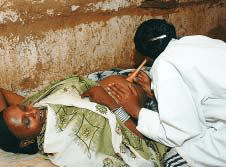The second visit
The second visit should be scheduled at 24-28 weeks of gestation. It is expected to take 20 minutes.
Objectives of the Second Visit
- Address complaints and concerns.
- Assess foetal well-being.
- Design individualised plan.
- Advice on existing social support.
- Update the risk assessment and based on that, decide on the need for referral.
a) History
- Personal history: note any changes since the first visit.
- Medical history:
- Review relevant issues of medical history as recorded at the first visit.
- Take note of diseases, injuries, or other conditions and additional histories for HIV-positive women since the first visit.
- Ensure intake of medicines, other than iron-foliate and other prescribed drugs.
- Check compliance for intake of iron.
- Note other medical consultations, hospitalisation or sick-leave in present pregnancy.
- Obstetric history:
- Ask the woman her feeding practice.
- Review relevant issues of obstetric history as recorded during the first visit.
- Record symptoms and events since the first visit. Ask about:
- Vaginal bleeding and vaginal discharge.
- Dysuria, frequency, urgency during micturition.
- Severe pr persistent headache or blurred vision.
- Difficulty breathing.
- Fever.
- Severe abdominal pain.
- Foetal movement (note time of first recognition in the medical record)..
- Signs and symptoms of severe anaemia.
- Other specific symptoms or events such as opportunistic infections in HIV-positive women.
- Abnormal changes in body features or physical capacity (e.g. peripheral swelling, shortness of breath), observed by the woman. herself, by her partner or other family members.
- Check habits regarding alcohol, smoking and others.
b) Physical Examination:
- Note general appearance; look for signs of physical abuse.
- Measure vital signs and record (BP, PR, RR, Temperature, weight).
- Measure uterine height in centimetres (see figure 6.2).
- Auscultate for foetal heartbeat and record (see figure 6.1).
- Check for other signs of disease; shortness of breath, cough, generalised oedema and the like.

Figure 6.1. Auscultation of the fetal heartbeat

Figure 6.2. Measuring fundal height.
c) Advice, Questions and Answers, and Scheduling the Next Appointment:
- Repeat all the advice given at the first visit.
- Questions and answers: give time for free communication.
- Give advice on whom to call or where to go in case of bleeding, abdominal pain or any other emergency, or when in need of other advice.
- This information should be confirmed in writing (on the antenatal card), at the first visit.
- Schedule appointment for the third visit ( at 30-32 weeks).
d) Maintain Complete Records
- Complete clients' card on the integrated client card.
- Complete appointment card.
- Enter information on registration logbook.
Last modified: Sunday, 26 February 2017, 5:38 PM